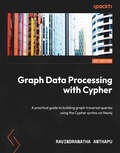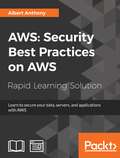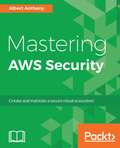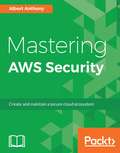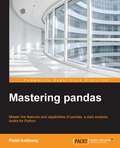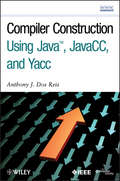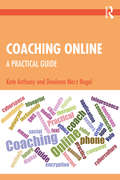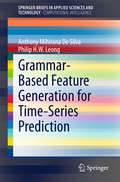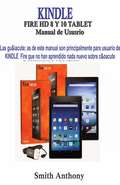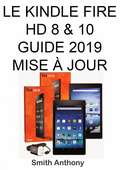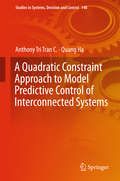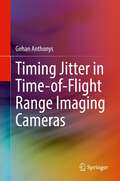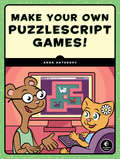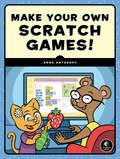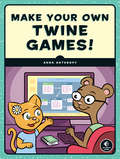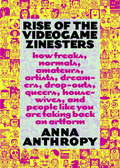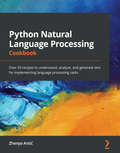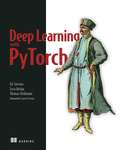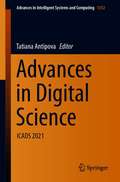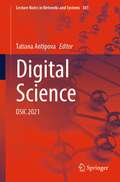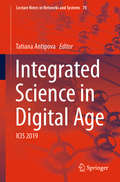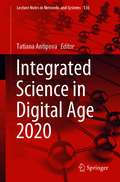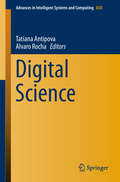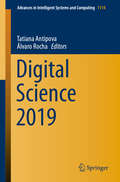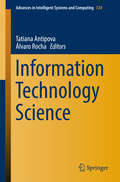- Table View
- List View
Graph Data Processing with Cypher: A practical guide to building graph traversal queries using the Cypher syntax on Neo4j
by Ravindranatha AnthapuGet acquainted with Cypher in a guided manner quickly and learn how to query the graph databases with efficient and performant queriesKey FeaturesWork with Cypher syntax and semantics while building graph traversal queriesGet up and running with advanced Cypher concepts like List, Maps, OPTIONAL MATCHMaster best practices in writing effective queries leveraging data modeling and patternsBook DescriptionWhile it is easy to learn and understand the Cypher declarative language for querying graph databases, it can be very difficult to master it. As graph databases are becoming more mainstream, there is a dearth of content and guidance for developers to leverage database capabilities fully. This book fills the information gap by describing graph traversal patterns in a simple and readable way.This book provides a guided tour of Cypher from understanding the syntax, building a graph data model, and loading the data into graphs to building queries and profiling the queries for best performance. It introduces APOC utilities that can augment Cypher queries to build complex queries. You'll also be introduced to visualization tools such as Bloom to get the most out of the graph when presenting the results to the end users.After having worked through this book, you'll have become a seasoned Cypher query developer with a good understanding of the query language and how to use it for the best performance.What you will learnWrite Cypher queries from basic to advanced levelMap the source data to the graph data model in an iterative fashionLoad the data into a graph using LOAD CSV, APOC, and client driversMap the business questions to graph queries effectivelyIdentify query performance issues and fix themExtend capabilities of Cypher using APOC utilitiesWork with graph visualization tools like Bloom and BrowserWho this book is forThis book is targeted at Database Administrator, Database Developers, Graph Database Developers, and Graph Database Architects. This book will also help someone migrate from a DBA role to a graph data engineer or data scientistIf you are working with graph databases and need to learn Cypher, or are a basic Cypher developer who wants to get better at data modeling and tuning queries to build performant Cypher queries, then this is the book for you.
AWS: Learn to secure your data, servers, and applications with AWS
by Albert AnthonyDelve deep into various security aspects of AWS to build and maintain a secured environmentKey Features●Learn to secure your network, infrastructure, data, and applications in AWS cloud●Use AWS managed security services to automate security●Dive deep into various aspects such as the security model, compliance, access management and much more to build and maintain a secured environment●Explore Cloud Adoption Framework (CAF) and its components●Embedded with assessments that will help you revise the concepts you have learned in this bookBook DescriptionWith organizations moving their workloads, applications, and infrastructure to the cloud at an unprecedented pace, security of all these resources has been a paradigm shift for all those who are responsible for security; experts, novices, and apprentices alike.This book focuses on using native AWS security features and managed AWS services to help you achieve continuous security. Starting with an introduction to Virtual Private Cloud (VPC) to secure your AWS VPC, you will quickly explore various components that make up VPC such as subnets, security groups, various gateways, and many more.You will also learn to protect data in the AWS platform for various AWS services by encrypting and decrypting data in AWS. You will also learn to secure web and mobile applications in AWS cloud.This book is ideal for all IT professionals, system administrators, security analysts, solution architects, and chief information security officers who are responsible for securing workloads in AWS for their organizations.This book is embedded with useful assessments that will help you revise the concepts you have learned in this book.What you will learn●Get familiar with VPC components, features, and benefits●Learn to create and secure your private network in AWS●Explore encryption and decryption fundamentals●Understand monitoring, logging, and auditing in AWS●Ensure data security in AWS●Secure your web and mobile applications in AWS●Learn security best practices for IAM, VPC, shared security responsibility model, and so onWho this book is forThis book is for all IT professionals, system administrators, security analysts, solution architects, and chief information security officers who are responsible for securing workloads in AWS for their organizations.
Mastering AWS Security
by Albert Anthony<P><P>An informative guide to implementing and using AWS security services effectively <P><P>About This Book <P><P>Learn to secure your network, infrastructure, data and applications in AWS cloud <P><P>Log, monitor and audit your AWS resources for continuous security and continuous compliance in AWS cloud <P><P>Use AWS managed security services to automate security, and focus on your business rather than being distracted by security risks and issues with AWS security <P><P>Cover topics including the security model, compliance, access management and much more to build and maintain a secure environment <P><P>Who This Book Is For <P><P>This book is for all IT professionals, system administrators and security analysts, solution architects and Chief Information Security Officers who are responsible for securing workloads in AWS for their organizations. Master AWS Security is helpful for all Solutions Architects who want to design and implement secure architecture on AWS by the following security by design principle, and is beneficial for personnel in Auditors and Project Management roles who want to understand how they can audit AWS workloads and manage security in AWS. <P><P>If you're learning AWS or championing AWS adoption in your organization, you should read this book to build security in all your workloads. You'll benefit from understanding the security footprint of all major AWS services for multiple domains, use cases, and scenarios. <P><P>What You Will Learn <P><P>Learn about AWS Identity Management and Access control <P><P>Gain knowledge to create and secure your private network in AWS <P><P>Understand and secure your infrastructure in AWS <P><P>Understand monitoring, logging and auditing in AWS <P><P>Ensure Data Security in AWS <P><P>Learn to secure your applications in AWS <P><P>Explore AWS Security best practices <P><P>In Detail <P><P>Mastering AWS Security starts with an exploration of the fundamentals of the shared security responsibility model. This book tells you how you can enable continuous security, continuous auditing, and continuous compliance by automating security in AWS with the tools, services, and features available. <P><P>Moving on, you'll learn about access control in AWS for all resources. You'll also cover the security of your network, servers, data and applications in the AWS cloud using native AWS security services. <P><P>By the end of this book, you will understand the complete AWS Security landscape, covering all aspects of end-to-end software and hardware security along with logging, auditing, and compliance of your entire IT environment in the AWS cloud. <P><P>Lastly, Mastering AWS Security wraps up with AWS best practices for security.
Mastering AWS Security
by Albert AnthonyIn depth informative guide to implement and use AWS security services effectively. About This Book • Learn to secure your network, infrastructure, data and applications in AWS cloud • Log, monitor and audit your AWS resources for continuous security and continuous compliance in AWS cloud • Use AWS managed security services to automate security. Focus on increasing your business rather than being diverged onto security risks and issues with AWS security. • Delve deep into various aspects such as the security model, compliance, access management and much more to build and maintain a secure environment. Who This Book Is For This book is for all IT professionals, system administrators and security analysts, solution architects and Chief Information Security Officers who are responsible for securing workloads in AWS for their organizations. It is helpful for all Solutions Architects who want to design and implement secure architecture on AWS by the following security by design principle. This book is helpful for personnel in Auditors and Project Management role to understand how they can audit AWS workloads and how they can manage security in AWS respectively. If you are learning AWS or championing AWS adoption in your organization, you should read this book to build security in all your workloads. You will benefit from knowing about security footprint of all major AWS services for multiple domains, use cases, and scenarios. What You Will Learn • Learn about AWS Identity Management and Access control • Gain knowledge to create and secure your private network in AWS • Understand and secure your infrastructure in AWS • Understand monitoring, logging and auditing in AWS • Ensure Data Security in AWS • Learn to secure your applications in AWS • Explore AWS Security best practices In Detail Mastering AWS Security starts with a deep dive into the fundamentals of the shared security responsibility model. This book tells you how you can enable continuous security, continuous auditing, and continuous compliance by automating your security in AWS with the tools, services, and features it provides. Moving on, you will learn about access control in AWS for all resources. You will also learn about the security of your network, servers, data and applications in the AWS cloud using native AWS security services. By the end of this book, you will understand the complete AWS Security landscape, covering all aspects of end - to -end software and hardware security along with logging, auditing, and compliance of your entire IT environment in the AWS cloud. Lastly, the book will wrap up with AWS best practices for security. Style and approach The book will take a practical approach delving into different aspects of AWS security to help you become a master of it. It will focus on using native AWS security features and managed AWS services to help you achieve continuous security and continuous compliance.
Mastering pandas
by Femi AnthonyThis book is intended for Python programmers, mathematicians, and analysts who already have a basic understanding of Python and wish to learn about its data analysis capabilities in depth.
Compiler Construction Using Java, JavaCC, and Yacc
by Anthony J. Dos ReisBroad in scope, involving theory, the application of that theory, and programming technology, compiler construction is a moving target, with constant advances in compiler technology taking place. Today, a renewed focus on do-it-yourself programming makes a quality textbook on compilers, that both students and instructors will enjoy using, of even more vital importance. This book covers every topic essential to learning compilers from the ground up and is accompanied by a powerful and flexible software package for evaluating projects, as well as several tutorials, well-defined projects, and test cases.
Coaching Online: A Practical Guide
by Kate Anthony DeeAnna Merz NagelTranslating traditional coaching methods and competencies for use in the online world, this informative and timely guide shows coaches how to transform their face-to-face practice into one that utilises technological means of communication with clients, mentors, and everyone else associated with their practice. The book offers up-to-the-minute practical and ethical information from two world-expert coaches, leaning on their combined 50 years of experience and study. It covers the practice of online coaching via email, chat, audio/telephone and video methods, as well as the ethics of online coaching (including an ethical framework), case material, supervision, mentoring and training, and a look into the future of the coaching profession in light of technological developments and the culture of cyberspace. Whether you are a coach-in-training or established Coaching Master, this book is an accessible and invaluable tool for taking and maintaining your coaching services online.
Grammar-Based Feature Generation for Time-Series Prediction
by Anthony Mihirana De Silva Philip H. W. LeongThis book proposes a novel approach for time-series prediction using machine learning techniques with automatic feature generation. Application of machine learning techniques to predict time-series continues to attract considerable attention due to the difficulty of the prediction problems compounded by the non-linear and non-stationary nature of the real world time-series. The performance of machine learning techniques, among other things, depends on suitable engineering of features. This book proposes a systematic way for generating suitable features using context-free grammar. A number of feature selection criteria are investigated and a hybrid feature generation and selection algorithm using grammatical evolution is proposed. The book contains graphical illustrations to explain the feature generation process. The proposed approaches are demonstrated by predicting the closing price of major stock market indices, peak electricity load and net hourly foreign exchange client trade volume. The proposed method can be applied to a wide range of machine learning architectures and applications to represent complex feature dependencies explicitly when machine learning cannot achieve this by itself. Industrial applications can use the proposed technique to improve their predictions.
KINDLE FIRE HD 8 Y 10 Manual de Ususrio: La Manera Rápida y Fácil De Entender Su Kindle Fire HD Y Solucionar Problemas Comunes
by Smith AnthonyLas guías de este manual son principalmente para usuarios de KINDLE Fire que no han aprendido nada nuevo sobre cómo maximizar su Kindle Fire HD 8 y 10. Obtendrás nuevos consejos y trucos ocultos que te harán dominar tu dispositivo. El manual le llevará paso a paso a las características avanzadas de los procesos Kindle Fire HD 8 y 10 en la configuración inicial, funciones básicas, ajustes avanzados y muchos más. Otra información importante que obtendrá de este libro incluye; Razón para Kindle Fire HD 8 y 10 Cómo configurar el Kindle fire HD 8 y 10 La mejor manera de cargar su Kindle Fire HD 8 y 10 USANDO UNA COMPUTADORA CON UN ADAPTADOR DE PARED Navegación en la pantalla del dispositivo Compras en Amazon Funcionalidad de los tres botones de la pantalla del dispositivo Compras en Amazon CÓMO REFLEJAR SU KINDLE FIRE HD A SU TV USANDO EL FIRE STICK Cómo acelerar tu fuego de fuego lento HD Mi fuego de fuego no se enciende. Tu enciende fuego HD no se cargará. Mi fuego encendido no tiene sonido Cómo maximizar Alexa on a fire HD Tablet Capacidad de poder cambiar el color del teclado Capacidad para cambiar la voz de texto a voz Apagado automático para el Wi-Fi Capacidad para obtener emojis o emoticonos en el teclado Capacidad para cambiar el comportamiento de autocorrección Cómo encontrar su Tablet perdido utilizando GPS Fondos de pantalla Capacidad de reflejar el fuego de su Kindle No lo demore más, navegue hacia arriba y haga clic en el "BUY BUTTON" para obtener este manual para dominar su dispositivo y convertirse en un experto en Kindle Fire HD.
Le Kindle Fire HD 8 & 10 Guide 2019 Mise À Jour: Moyens faciles et rapides pour comprendre votre Kindle Fire HD et solution aux problèmes courants
by Smith AnthonyTHE KINDLE FIRE HD 8 & 10 GUIDE 2019 MISE À JOUR Les guides de ce manuel sont principalement destinés aux utilisateurs de KINDLE Fire qui n'ont rien appris de nouveau sur la façon de maximiser votre Kindle Fire HD 8 et 10. Vous obtiendrez de nouveaux trucs et astuces cachés qui vous permettront de maîtriser votre appareil. Ce manuel vous guidera pas à pas vers les fonctions avancées des processus Kindle Fire HD 8 et 10 sur la configuration initiale, les fonctions de base, les paramètres avancés et bien plus encore. D'autres informations importantes que vous obtiendrez de ce livre incluent ; Raison du Kindle Fire HD 8 et 10 Comment mettre en place Kindle feu HD 8 et 10 La meilleure façon de charger votre Kindle Fire HD 8 et 10 À L'AIDE D'UN ORDINATEUR À L'AIDE D'UN ADAPTATEUR MURAL Navigation sur l'écran de votre terminal Magasiner sur Amazon Fonctionnalité des trois boutons de l'écran de votre appareil Magasiner sur Amazon COMMENT FAIRE UN MIROIR DE VOTRE FEU ALLUMÉ HD À VOTRE TÉLÉVISEUR À L'AIDE D'UN BÂTON DE FEU Comment accélérer votre feu lent HD Mon feu allumé ne s'allume pas. Votre feu allumé HD ne se charge pas Mon feu allumé n'a pas de son Comment maximiser Alexa sur un feu HD Comprimé Possibilité de pouvoir changer la couleur du clavier Possibilité de changer le texte à la voix de la parole Arrêt automatique pour le Wi-Fi Possibilité d'avoir des émojis ou des émoticônes sur le clavier Possibilité de changer le comportement d'autocorrection Comment retrouver votre tablette perdue à l'aide du GPS Fonds d'écran Capacité de refléter votre feu de Kindle Ne tergiversez pas davantage, naviguez vers le haut et cliquez sur le bouton "ACHETER" pour obtenir ce manuel afin de maîtriser votre appareil et devenir un expert en K
A Quadratic Constraint Approach to Model Predictive Control of Interconnected Systems (Studies In Systems, Decision And Control #148)
by Anthony Tri Tran C. Quang HaThis book focuses on the stabilization and model predictive control of interconnected systems with mixed connection configurations. It introduces the concept of dissipation-based quadratic constraint for developing attractivity assurance methods for interconnected systems. In order to develop these methods, distributed and decentralized architectures are employed, whereby the communication between subsystems is fully connected, partially connected, or completely disconnected. Given that the control inputs are entirely or partially decoupled between subsystems and no additional constraints are imposed on the interactive variables beyond the coupling constraint itself, the proposed approaches can be used with various types of systems and applications. Further, the book describes how the effects of coupling delays and data losses in device networks are resolved. From a practical perspective, the innovations presented are of benefit in applications in a broad range of fields, including the process and manufacturing industries, networked robotics, and network-centric systems such as chemical process systems, power systems, telecommunication networks, transportation networks, and, no less importantly, supply chain automation.
Timing Jitter in Time-of-Flight Range Imaging Cameras
by Gehan AnthonysThis book explains how depth measurements from the Time-of-Flight (ToF) range imaging cameras are influenced by the electronic timing-jitter. The author presents jitter extraction and measurement techniques for any type of ToF range imaging cameras. The author mainly focuses on ToF cameras that are based on the amplitude modulated continuous wave (AMCW) lidar techniques that measure the phase difference between the emitted and reflected light signals. The book discusses timing-jitter in the emitted light signal, which is sensible since the light signal of the camera is relatively straightforward to access. The specific types of jitter that present on the light source signal are investigated throughout the book. The book is structured across three main sections: a brief literature review, jitter measurement, and jitter influence in AMCW ToF range imaging.
Make Your Own PuzzleScript Games!
by Anna AnthropyFun introduction to game development by well-known game designer using PuzzleScript, a free online tool for creating puzzles/platform games.PuzzleScript is a free, web-based tool you can use to create puzzle games. In a PuzzleScript game, you move objects around to solve problems and play through the levels.In Make Your Own PuzzleScript Games! you'll learn how to use PuzzleScript to create interactive games--no programming experience necessary! Learn the basics like how to make objects, create rules, and add levels. You'll also learn how to edit, test, and share your games online.Learn how to: • Decorate your game with fun backgrounds • Write rules that define how objects interact • Add obstacles like laser guns and guards • Herd cats and even pull off a robot heist!With colorful illustrations and plenty of examples for inspiration, Make Your Own PuzzleScript Games! will take you from puzzle solver to game designer in just a few clicks!
Make Your Own Scratch Games!: With The Free Tools Twine, Puzzlescript, And Scratch
by Anna AnthropyLearn to make interactive games with Scratch—the beginner-friendly, block-based programming language from the MIT Media Lab! Anna Anthropy, game designer extraordinaire, will show you how to do everything from building a game map to creating animations and debugging the end product. Take a peek inside the history of video game design, learn programming basics, and turn your ideas into creative games that you can play and share with your friends.Learn how to:•Draw characters like a hungry, leaf-eating bug•Animate characters—make them walk, jump, climb, and fall!•Create objects for your player to collect and obstacles to avoid•Design multiple levels to create a cave exploring platform game•Create sound effects and music for your games•Share your games online and use player feedback to improve your gamesIsn’t it time to Make Your Own Scratch Games? The world is waiting!Covers Scratch 3.0
Make Your Own Twine Games!
by Anna AnthropyBring your game ideas to life with Twine! Twine is a free online tool that lets anyone new to programming create their own interactive, story-based adventure games in a web page. In Make Your Own Twine Games!, game designer Anna Anthropy takes you step-by-step through the game development process, from coming up with a basic idea to structuring your game. You’ll learn the basics of Twine like how to use links and apply images and formatting to make your game look more distinct. You’ll get tips on how to test your game, export it, and publish it online, and even understand more advanced features like scripting to get your game to remember and respond to player choices. As you make your way through the book and begin crafting your own interactive fiction, you’ll learn other cool tricks like how to:• Write stories that follow multiple paths using hyperlinks• Create variables to track your player’s actions• Add scripting like “if” and “else” to decide when ghosts should appear in your game• Use hooks to add fancy touches like text effects, pictures, and sound With example games to act as inspiration, Make Your Own Twine Games! will take you from story-teller to game designer in just a few clicks! Ready player one? The game starts now.Covers Twine 2
Rise of the Videogame Zinesters
by Anna Anthropy"Anna Anthropy is a key personality in the ongoing paradigm shift that is slowly changing the way videogames are understood, by creators and players, and by the wider culture." --Patrick Alexander, Eegra.com"Equal parts autobiography, ethnography, and how-to manual, this book concisely makes the case for the unique power of 'zinester' games."--Adam Parrish, NYU's Interactive Telecommunication Program (Tisch School of the Arts), and author of the ZZT game "Winter""These days, everybody can make and distribute a photograph, or a video, or a book. Rise of the Videogame Zinesters shows you that everyone can make a videogame, too. But why should they? For Anna Anthropy, it's not for fame or for profit, but for the strange, aimless beauty of personal creativity."--Ian Bogost, Director, Graduate Program in Digital Media, Georgia Institute of Technology"Rise is a great guidebook to understanding--and more importantly, participating in--this dynamically evolving culture." --Jim Munroe, co-founder of the Hand Eye Society and the Difference Engine Initiative"Here, Anna Anthropy demonstrates how people from every background and walk of life are breaking free of the commercial cowardice of major publishers, and bringing their individual visions of the game to life. . . . If game design is to be an art, as those of us who love games fervently hope, it must be rescued from its crushing commercial pressures. You can be a part of its future." --Greg Costikyan, author of I Have No Mouth and I Must Design"Anna gives the world of video games a crucial perspective from her seat of authority within outsider culture, and illustrates how essential it is for the space to empower voices of all kinds if it is to evolve." --Leigh Alexander, editor-at-large of Gamasutra
Python Natural Language Processing Cookbook: Over 50 recipes to understand, analyze, and generate text for implementing language processing tasks
by Zhenya AnticGet to grips with solving real-world NLP problems, such as dependency parsing, information extraction, topic modeling, and text data visualizationKey FeaturesAnalyze varying complexities of text using popular Python packages such as NLTK, spaCy, sklearn, and gensimImplement common and not-so-common linguistic processing tasks using Python librariesOvercome the common challenges faced while implementing NLP pipelinesBook DescriptionPython is the most widely used language for natural language processing (NLP) thanks to its extensive tools and libraries for analyzing text and extracting computer-usable data. This book will take you through a range of techniques for text processing, from basics such as parsing the parts of speech to complex topics such as topic modeling, text classification, and visualization. Starting with an overview of NLP, the book presents recipes for dividing text into sentences, stemming and lemmatization, removing stopwords, and parts of speech tagging to help you to prepare your data. You'll then learn ways of extracting and representing grammatical information, such as dependency parsing and anaphora resolution, discover different ways of representing the semantics using bag-of-words, TF-IDF, word embeddings, and BERT, and develop skills for text classification using keywords, SVMs, LSTMs, and other techniques. As you advance, you'll also see how to extract information from text, implement unsupervised and supervised techniques for topic modeling, and perform topic modeling of short texts, such as tweets. Additionally, the book shows you how to develop chatbots using NLTK and Rasa and visualize text data. By the end of this NLP book, you'll have developed the skills to use a powerful set of tools for text processing.What you will learnBecome well-versed with basic and advanced NLP techniques in PythonRepresent grammatical information in text using spaCy, and semantic information using bag-of-words, TF-IDF, and word embeddingsPerform text classification using different methods, including SVMs and LSTMsExplore different techniques for topic modeling such as K-means, LDA, NMF, and BERTWork with visualization techniques such as NER and word clouds for different NLP toolsBuild a basic chatbot using NLTK and RasaExtract information from text using regular expression techniques and statistical and deep learning toolsWho this book is forThis book is for data scientists and professionals who want to learn how to work with text. Intermediate knowledge of Python will help you to make the most out of this book. If you are an NLP practitioner, this book will serve as a code reference when working on your projects.
Deep Learning with PyTorch
by Luca Pietro Antiga Eli Stevens Thomas Viehmann&“We finally have the definitive treatise on PyTorch! It covers the basics and abstractions in great detail. I hope this book becomes your extended reference document.&” —Soumith Chintala, co-creator of PyTorch Key Features Written by PyTorch&’s creator and key contributors Develop deep learning models in a familiar Pythonic way Use PyTorch to build an image classifier for cancer detection Diagnose problems with your neural network and improve training with data augmentation Purchase of the print book includes a free eBook in PDF, Kindle, and ePub formats from Manning Publications.About The Book Every other day we hear about new ways to put deep learning to good use: improved medical imaging, accurate credit card fraud detection, long range weather forecasting, and more. PyTorch puts these superpowers in your hands. Instantly familiar to anyone who knows Python data tools like NumPy and Scikit-learn, PyTorch simplifies deep learning without sacrificing advanced features. It&’s great for building quick models, and it scales smoothly from laptop to enterprise. Deep Learning with PyTorch teaches you to create deep learning and neural network systems with PyTorch. This practical book gets you to work right away building a tumor image classifier from scratch. After covering the basics, you&’ll learn best practices for the entire deep learning pipeline, tackling advanced projects as your PyTorch skills become more sophisticated. All code samples are easy to explore in downloadable Jupyter notebooks. What You Will Learn Understanding deep learning data structures such as tensors and neural networks Best practices for the PyTorch Tensor API, loading data in Python, and visualizing results Implementing modules and loss functions Utilizing pretrained models from PyTorch Hub Methods for training networks with limited inputs Sifting through unreliable results to diagnose and fix problems in your neural network Improve your results with augmented data, better model architecture, and fine tuning This Book Is Written For For Python programmers with an interest in machine learning. No experience with PyTorch or other deep learning frameworks is required. About The Authors Eli Stevens has worked in Silicon Valley for the past 15 years as a software engineer, and the past 7 years as Chief Technical Officer of a startup making medical device software. Luca Antiga is co-founder and CEO of an AI engineering company located in Bergamo, Italy, and a regular contributor to PyTorch. Thomas Viehmann is a Machine Learning and PyTorch speciality trainer and consultant based in Munich, Germany and a PyTorch core developer. Table of Contents PART 1 - CORE PYTORCH 1 Introducing deep learning and the PyTorch Library 2 Pretrained networks 3 It starts with a tensor 4 Real-world data representation using tensors 5 The mechanics of learning 6 Using a neural network to fit the data 7 Telling birds from airplanes: Learning from images 8 Using convolutions to generalize PART 2 - LEARNING FROM IMAGES IN THE REAL WORLD: EARLY DETECTION OF LUNG CANCER 9 Using PyTorch to fight cancer 10 Combining data sources into a unified dataset 11 Training a classification model to detect suspected tumors 12 Improving training with metrics and augmentation 13 Using segmentation to find suspected nodules 14 End-to-end nodule analysis, and where to go next PART 3 - DEPLOYMENT 15 Deploying to production
Advances in Digital Science: ICADS 2021 (Advances in Intelligent Systems and Computing #1352)
by Tatiana AntipovaThis book gathers selected papers that were submitted to the 2021 International Conference on Advances in Digital Science (ICADS 2021) that aims to make available the discussion and the publication of papers on all aspects of single and multi-disciplinary research on Conference topics (https://ics.events/icads-2021/). ICADS 2021 was held on February 19–21, 2021. An important characteristic feature of Conference is the short publication time and world-wide distribution. Written by respected researchers, the book covers a range of innovative topics related to: Advances in Digital Agriculture & Food Technology, Advances in Digital Economics, Advances in Digital Education, Advances in Public Health Care, Hospitals & Rehabilitation, Advances in Digital Social Media, Advances in Digital Technology & Applied Sciences, Advances in E-Information Systems, and Advances in Public Administration.This book is useful for private and professional non-commercial research and classroom use (e.g. sharing the contribution by mail or in hard copy form with research colleagues for their professional non-commercial research and classroom use); for use in presentations or handouts for any level students, researchers, etc.; for the further development of authors’ scientific career (e.g. by citing, and attaching contributions to job or grant application).
Digital Science: DSIC 2021 (Lecture Notes in Networks and Systems #381)
by Tatiana AntipovaThis book gathers selected papers that were submitted to the 2021 International Conference on Digital Science (DSIC 2021) that aims to make available the discussion and the publication of papers on all aspects of single and multidisciplinary research on conference topics. DSIC 2021 was held on October 15–17, 2021. An important characteristic feature of conference is the short publication time and worldwide distribution. Written by respected researchers, the book covers a range of innovative topics related to: digital economics; digital education; digital engineering; digital environmental sciences; digital finance, business and banking; digital health care, hospitals and rehabilitation; digital media; digital medicine, pharma and public health; digital public administration; digital technology and applied sciences. This book may be used for private and professional non-commercial research and classroom use (e.g., sharing the contribution by mail or in hard copy form with research colleagues for their professional non-commercial research and classroom use); for use in presentations or handouts for any level students, researchers, etc.; for the further development of authors’ scientific career (e.g., by citing, and attaching contributions to job or grant application).
Integrated Science in Digital Age: ICIS 2019 (Lecture Notes in Networks and Systems #78)
by Tatiana AntipovaThis book gathers selected papers presented at the 2019 International Conference on Integrated Science in Digital Age (ICIS 2019), which was jointly supported by the Institute of Certified Specialists (ICS), Russia and Springer and held in Batumi, Georgia on May 10–12, 2019. The ICIS 2019 received roughly 50 contributions, by authors hailing from six countries. Following a peer-review process, the Scientific Committee – a multidisciplinary group of 110 experts from 38 countries around the globe – selected roughly 60% for publication. The main topics covered include: Artificial Intelligence Research; Digital Business & Finance; Educational Sciences; Health Management Informatics; Public Administration in the Digital Age; and Social Problem-solving.
Integrated Science in Digital Age 2020 (Lecture Notes in Networks and Systems #136)
by Tatiana AntipovaThis book presents the proceedings of the 2020 International Conference on Integrated Science in Digital Age, which was jointly supported by the Institute of Certified Specialists (Russia) and Springer, and was held on May 1–3, 2020.The conference provided an international forum for researchers and practitioners to present and discuss the latest innovations, trends, results, experiences and concerns in the various areas of integrated science in the digital age. The main goal of the conference was to efficiently disseminate original findings in the natural and social sciences, covering topics such as blockchain & cryptocurrency; computer law & security; digital accounting & auditing; digital business & finance; digital economics; digital education; digital engineering; machine learning; smart cities in the digital age; health policy & management; and information management.
Digital Science (Advances in Intelligent Systems and Computing #850)
by Tatiana Antipova Alvaro RochaThis book gathers the proceedings of the 2018 International Conference on Digital Science (DSIC’18), held in Budva, Montenegro, on October 19 – 21, 2018. DSIC’18 was an international forum for researchers and practitioners to present and discuss the latest innovations, trends, results, experiences and concerns in Digital Science. The main goal of the Conference was to efficiently disseminate original findings in the natural and social sciences, art & the humanities. The contributions address the following topics: Digital Agriculture & Food Technology Digital Art & Humanities Digital Economics Digital Education Digital Engineering Digital Environmental Sciences Digital Finance, Business & Banking Digital Health Care, Hospitals & Rehabilitation Digital Media Digital Medicine, Pharma & Public Health Digital Public Administration Digital Technology & Applied Sciences Digital Virtual Reality
Digital Science 2019: Icis 2019 (Advances in Intelligent Systems and Computing #1114)
by Tatiana Antipova Álvaro RochaThis book presents the proceedings of the 2019 International Conference on Digital Science (DSIC 2019), held in Limassol, Cyprus, on October 11–13, 2019. DSIC 2019 was an international forum for researchers and practitioners to present and discuss the most recent innovations, trends, results, experiences and concerns in digital science. The main goal of the conference was to efficiently disseminate original findings in the natural and social sciences, art & the humanities. The contributions in the book address the following topics: Digital Art & Humanities Digital Economics Digital Education Digital Engineering Digital Finance, Business & Banking Digital Healthcare, Hospitals & Rehabilitation Digital Media Digital Medicine, Pharma & Public Health Digital Public Administration Digital Technology & Applied Sciences Digital Virtual Reality
Information Technology Science (Advances In Intelligent Systems And Computing #724)
by Tatiana Antipova Álvaro RochaThis book includes a selection of articles from the 2017 International Conference on Information Technology Science (MosITS’17), held on December 1-3, 2017, at the Izmailovo Convention Centre, Moscow, Russia.MosITS’17 was an international forum for researchers and practitioners to present and discuss the most recent innovations, trends, results, experiences and concerns in various areas of information technology science.The papers cover topics such as information technology in communication, management science, public administration, economics, business & finance, history, health & rehabilitation, education, and in architecture.
